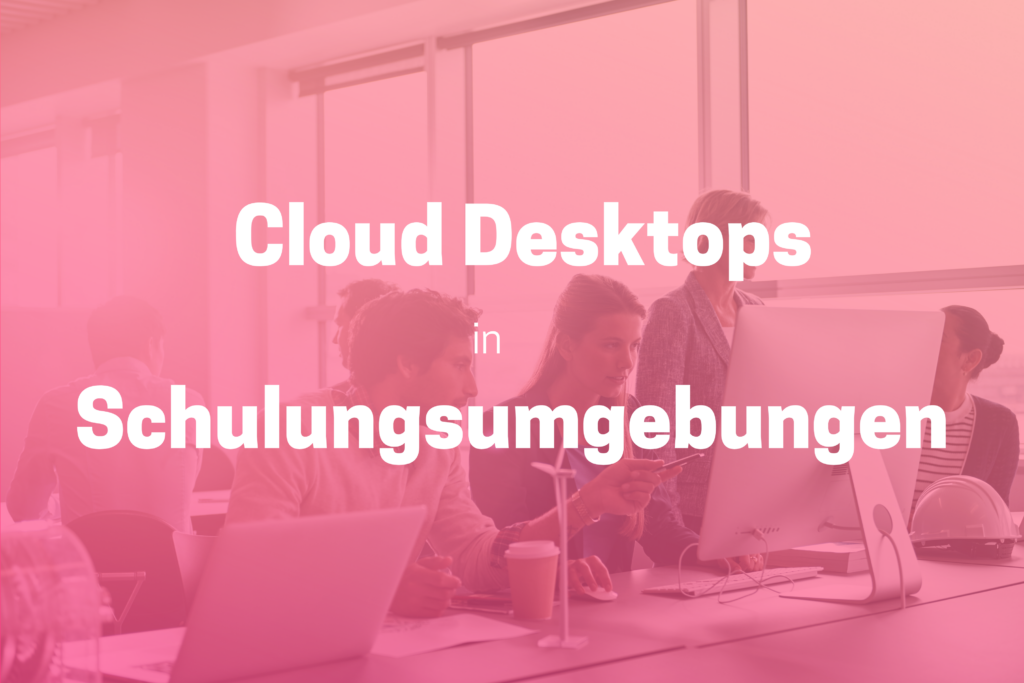Cloud desktops help training organizations to manage training more easily and flexibly.

The preparation and follow-up of training sessions takes place
still very shirt-sleeved in many places in 2019. Especially for software training
the end devices must be refueled before each new training session. With several
Due to low bandwidths, training locations often have to be equipped with additional local
image server are kept and maintained.
After playing, a tour is often carried out to check that all computers are working as intended.
function as desired.
This effort pushes IT to its limits. Rooms are then exchanged,
because the number of participants has changed at short notice, the chaos is perfect.
The increasing demand for on-site training, i.e. at the customer’s premises, requires
in the concept mentioned above, additional hardware in the form of notebooks and a
even higher administrative expenses.
The above scenario is still commonplace, but in times of digitalization, in times in which even training organizations have to completely reinvent themselves, actually more than out of date.
What would the ideal training environment look like?
- All training courses could be held on any end device be displayed
- Training courses can be held at any location
- Administration must be managed centrally can
- The number of participants per training course can range from 1 go to infinity
- For the preparation, it doesn’t matter whether there are 1 or 100 participants
I’m sure you can think of even more points.
“Can everything be e-learning?” I can already hear one or two
say to others. E-learning is the topic that drives the industry. We
have to rethink our learning methods of the last 20 years, and that’s a good thing
like this.
However, e-learning will not replace traditional forms of education. In addition
In addition, creating and maintaining e-learning content is expensive and time-consuming.
is.
Is there no way out?
VDI would be a way out.
Virtual desktop infrastructures use centralized virtual desktops located in the training company’s data center instead of physical training computers. These virtual desktops can now be accessed flexibly from anywhere and with almost any end device. Since the computing power takes place in the data center, the requirements for the end devices are extremely low and almost independent of the training content.
Since virtualization runs on its own servers with VDI, the Unfortunately, scaling is only possible to a limited extent. The costs for this are also incurred even if no training courses are held. But the most problematic thing is, that VDI solutions do not offer the flexibility in image handling that training organizations need.
So what is the solution?
Cloud desktops are the way out.
Cloud desktops, also known as Desktop-as-a-Service (DaaS), run in the provider’s data center. There they can be dynamically added and deducted as required. Costs are generally only incurred when the desktops are in use.
Cloud desktops can also be accessed from anywhere and with any end device. The minimum requirement for most providers is an up-to-date browser. This means that the training desktops can be accessed not only from the end devices in the training center, but also from end devices at the customer’s premises or even from the participants’ private end devices. Unlike VDI solutions, Cloud Desktops do not require network separation from one classroom to another.
The management of images and the creation of users can be carried out either by the IT department of the training organization or even by the training manager himself. Many cloud desktops can also be fully controlled via an API, i.e. a programming interface.
Cloud desktops can also be integrated very well into new Integrate training methods such as e-learning. Just think of a blended Learning with Cloud Desktops for the practical part, or a Virtual Classroom where participants can access these and the cloud desktops from anywhere. access.
With cloud desktops, the provider is responsible for providing the hardware and virtualization, an environment can be very complex. quickly and without a great deal of specialist knowledge. Because the provider has a server farm with enough resources available for virtualization is also takes the issue of limited scalability off the table.
Despite all the positive aspects, there are also some disadvantages Attention should be paid to this. Of course, there is a dependency between Training organization and cloud provider. If the cloud service is not available, training courses have to be canceled, resulting in a loss of costs and image. Also a long contract commitment can deprive the customer of the necessary flexibility. As is so often the case, “therefore let he who binds himself (eternally) prove himself”.
Conclusion
In training environments, virtual infrastructures can demonstrate their
Playing the trump card to the full. Cloud-based environments in particular help training organizations
training easier and more flexible to manage. The fact that they can be used from anywhere
are available, you also support the training organization in setting up
of new training concepts.
As a first step, I recommend a POC environment. This is quickly set up
and shows you directly the advantages of cloud desktops.
Whether large process-oriented public cloud providers or smaller, more flexible ones
Cloud providers should be selected depends on the requirements and
expectations of the customer.
